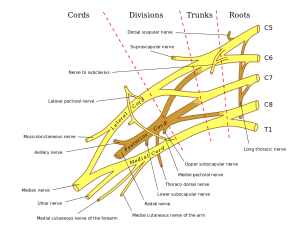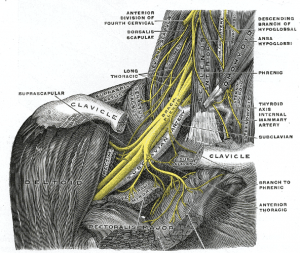What is Brachial Plexus and where is it located?
An assorted group of nerve fibers that begins at the root of the neck passes through the axilla (armpit or the underarm) and enters the upper arm of the human body is called Brachial Plexus. It is a useful network of nerve fibers that supply musculature to the upper limb of the human body. The plexus passes through the spinal cord, extends to the cervicoaxillary canal in the neck and lasts into the armpit. It is formed by the anterior divisions of the cervical spinal nerves that are termed C5, C6, C7 and C8, and the T1.
Brachial Plexus Anatomy
The plexus’ main function is to provide for the motor innervation (supplying of nerves) to all of the muscles to the upper arm. The Brachial Plexus has important five parts which are:
1. Roots – These refer to the starting point of the Brachial Plexus, formed by the spinal nerves C5, C6, C7, C8, and T1. These roots are formed by the anterior divisions of spinal nerves C5-T1. Once the roots are formed, the spinal nerves pass from between the anterior muscles to the base of the neck.
2. Trunks – From the base of the neck these roots then the roots of the Brachial Plexus unite and form three trunks. These are:
a) Superior trunk
b) Middle trunk
c) Inferior trunk
3. Divisions – The human neck has a posterior triangle shape within which the trunk divides itself into other two branches. One of these travels towards the frontal body (anterior) and the second one travel towards the back side of the body (posterior). So in total, there are three frontal and three of the latter nerve fibers which then pass on to the axilla (armpit or the underarm).
4. Cords – Once the frontal and latter divisions have crossed the threshold of the armpit area, they combine to form other new nerves. The three nerves are:
a) The lateral cord is formed by:
- The anterior part of the superior trunk
- The anterior part of the middle trunk
b) The posterior cord is formed by:
- The posterior part of superior trunk
- The posterior part of middle trunk
- The posterior part of inferior trunk
c) The medial cord is formed by:
- The anterior division of the inferior trunk.
5. Branches – In the upper limb near the axilla or the underarm, the three cords combined together give rise to five branches. These nerves provide continuous innervation to the muscles and skin present throughout the upper limb. These branches have five subtypes which are:
a) Musculocutaneous nerve branch which is a mixed nerve containing sensory and motor axons.
b) Ulnar nerve branch is derived from the medial cord. It functions like a motor nerve that supplies motor innervation to built-in muscles of the hand.
c) Median nerve branch is derived from the lateral and medial cords. It functions like a motor nerve that supplies motor innervation to flexor muscles in the forearm and built-in muscles of the thumb called the thenar muscles.
d) The axillary nerve branch comes from the posterior cord. It serves the function of motor innervation to deltoid and teres minor muscles while the sensory innervation comes from the skin just below the shoulder.
e) The radial nerve branch also comes from the posterior cord. It provides motor innervation to the extensor muscles of the elbow, wrist, and fingers.
Brachial Plexus Functions
1. A human body gets the cutaneous and muscular innervation through the Brachial Plexus which is supplied to the upper arm. However, there are two exceptions wherein the trapezius muscle is innervated by the spinal accessory nerve (CN XI) and second one wherein a specific area of the skin near the axilla (underarm) is innervated by the intercostobrachial nerve.
2. The Brachial Plexus plays a significant role by communicating through the sympathetic trunk that joins the plexus roots.
3. All the terminal branches of the Brachial Plexus have specific sensory, motor and perceptory functions.
Brachial Plexus Pictures
BPI (Brachial Plexus Injury)
Injuries
Injuries in the Brachial Plexus can be caused by labor and delivery. At birth, this injury is most likely caused by process of the delivery of the child wherein the Brachial Plexus has suffered a minor tear. Such injury can affect the sensory and motor functions in the infant. Sometimes the Brachial Plexus injuries can also occur due to bike or motor accidents, tear in the Brachial Plexus due to extreme muscle strain while playing a sport (tennis, basketball, badminton etc.)
There are various type of such injuries that can occur in the mild form of a tear or can be grievous as a root tearing away from the spinal cord, some of these types are:
- Avulsion – A severe injury wherein the nerve is torn away from its attachment to the spinal cord.
- Rupture – An injury wherein the nerve is torn, but not at the spinal cord attachment.
- Neuroma – In this injury, scar tissues tend to grow around the site of the injury and puts a lot amount of pressure on the injured nerve preventing the transfer of signals to the muscles.
- Neurapraxia – This is a type of injury wherein the nerve has been stretched and damaged but has not torn.
Diagnosis
The structure of the Brachial Plexus injuries is a complex one and only a thorough understanding and comprehensive examination of the nature of the injury can give a physician a better understanding of the treatment. Methodologies such as clinical examination, Electrodiagnostic analysis (EMG, NCV, SNAP, SSEP) and Imaging analysis (CT, MRI) are prescribed as evaluations. Some of these evaluations are repetitive and need continuous intervention for a progressive recovery of the patient.
Treatment
A spontaneous recovery may not be the solution to Brachial Plexus injury. However, the physician will need a deep study and analysis of the type and severity of the injury. Depending on the nature of injury the physician will advise either of the two options:
1. Non – surgical treatment of Brachial Plexus injuries
Physiotherapy or physical rehabilitation therapy is always part of the recovery process for any mild Brachial Plexus injuries.
2. Surgical treatment options for Brachial Plexus injuries
The degree of severity of the functions of the neck, back, forearm and any other parts in the upper limb will call for a surgery route to a proper recovery.
Brachial Plexus injuries can affect the cutaneous sensations and activities in the upper limb. These injuries occur due to stretching, wounds and even certain diseases. The injuries mostly occur in the posterior triangle of the neck or the armpit or the underarm. A physician is most likely to first test the movements through a physical test and then assessing it through comparison with normal abilities of the functions of the Brachial Plexus, this helps in assessing the complexity of the injury.
Commonly such injuries occur during accidents wherein the hand lands it weight on to the shoulder causing a stretch (road accidents – bike or car or even falling down a tree). These stretches cause ruptures in the various parts of the Brachial Plexus causing some amount of pain until the end of the spinal cord.
Frequently Asked Questions
1. How is the Brachial Plexus injury treated?
Either a surgical or a no-surgical treatment will be advised by the doctor. Non – surgical treatment includes Physiotherapy or physical rehabilitation therapy and surgical treatment considers the degree of severity of the functions of the neck, back, forearm and any other parts in the upper limb.
2. What is BPI?
Injuries to the Brachial Plexus are termed as BPI and can be caused by labor and delivery. Sometimes the Brachial Plexus injuries can also occur due to bike or motor accidents, tear in the Brachial Plexus also occur due to extreme muscle strain while playing a sport (tennis, basketball, badminton etc.). Some other types of BPI’s are avulsion, rupture, neuroma, and neurapraxia.



No comments yet.